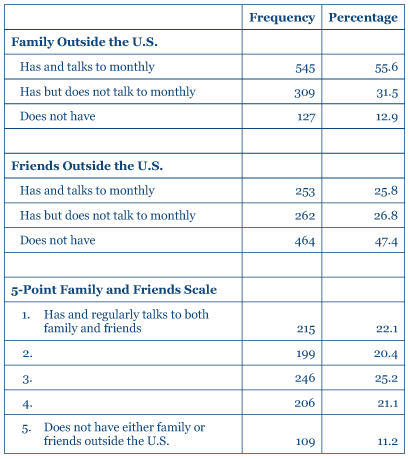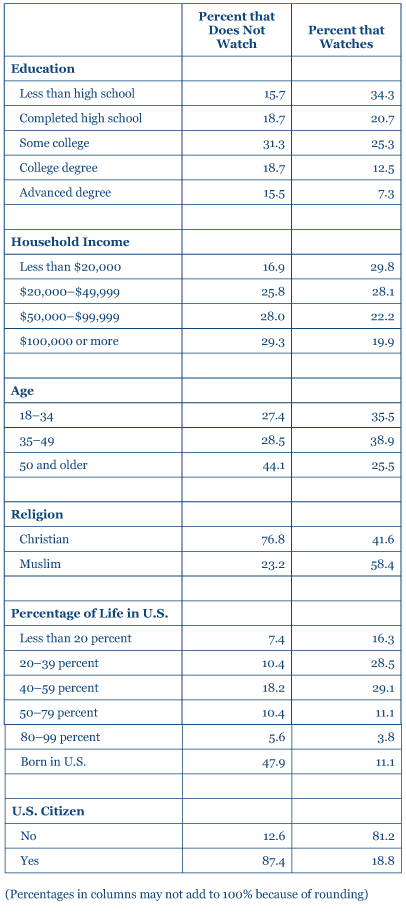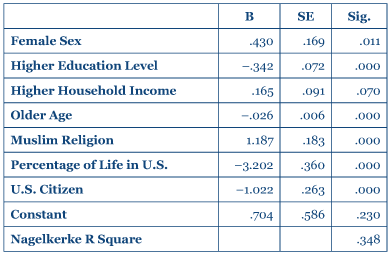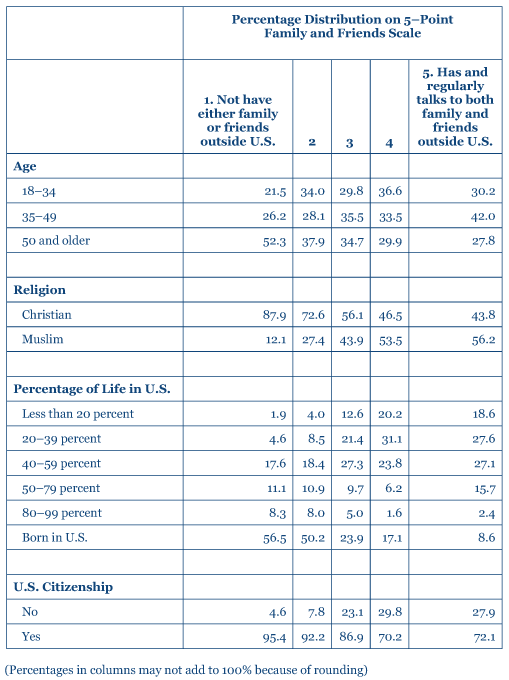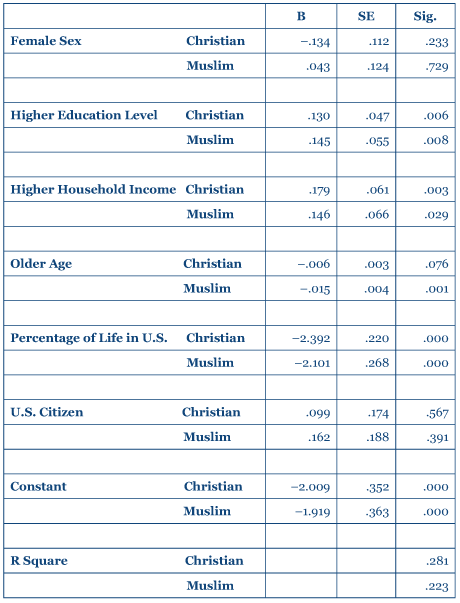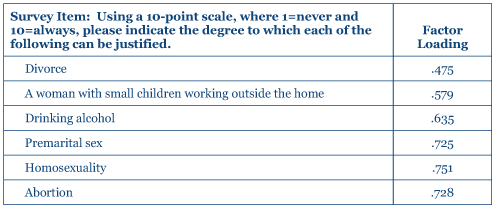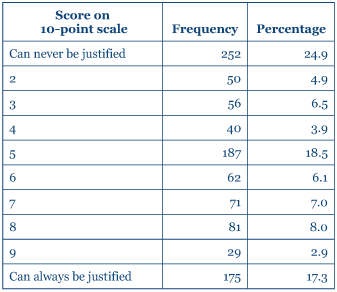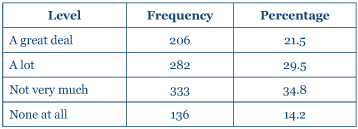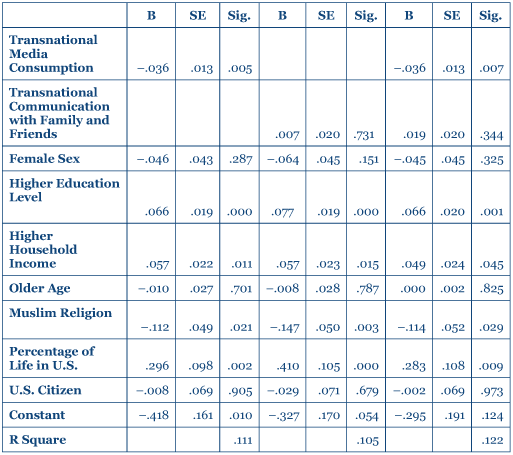1From July to December 2003, a path-breaking survey was carried out among the Arab-American community of Greater Detroit. Adhering to rigorous probability-based sampling procedures, and using bilingual interviewers from the community who were hired and trained for the study, 1,016 men and women aged 18 and over were asked a large number of questions about their attitudes and behavior, including their participation in transnational activities and communications. The survey was conducted in Wayne, Oakland, and Macomb counties; this includes the city of Dearborn. This is one of the largest Arab-American communities in the United States, and it is certainly the best organized and most politically important. To date, no other Arab-American community in the U.S. has been the site of a survey of comparable depth and rigor.
2The study, which was made possible by generous support from the Russell Sage Foundation, was designed and carried out by an interdisciplinary team of eight scholars at the University of Michigan and two other universities. The planning and implementation of the study also involved extensive consultation and coordination with leaders and institutions in the Detroit Arab-American community. Community involvement contributed significantly to the value and efficacy of the study. It also reduced the difficulty of asking potentially sensitive questions in the aftermath of the attacks of September 11, 2001, the U.S. invasion and occupation of Iraq, and the larger American campaign, or “war,” against terrorism.
3The present report1 summarizes findings from the Detroit Arab-American Study pertaining to transnational activities and experiences, particularly those involving communication with the Arab Middle East. In today’s increasingly globalized environment, it is easier than in the past to maintain transnational connections. Indeed, many immigrants of recent decades were undoubtedly participants in transnational networks involving ties to the United States before they came to this country. On the other hand, the intensity of participation in these networks may gradually diminish after years in the United States. Moreover, the same communication and transportation advances that make international connections possible tie Arab-Americans in Detroit to Arab-Americans throughout the U.S., thereby reducing the incentive to maintain ties to the Middle East for reasons of identity or perhaps even family. Thus, there are forces both promoting and diminishing transnationalism among the Arab-Americans of greater Detroit.
4Against this background, the present report investigates three sets of questions about the nature, extent, determinants, and consequences of transnational connections. The first identifies the dimensions of communication with the Arab Middle East that the survey instrument makes it possible to measure and presents the distribution of respondent behavior with respect to these dimensions. It also examines the relationship between transnational ties and ties with Arab-Americans outside Michigan but inside the United States. Second, the report examines the demographic locus of variation on these dimensions. Specifically, it compares transnational activities and experiences among respondent categories based on sex, education, age, household income, religion, country of ancestry, whether or not a person was born in the U.S. or is a U.S. citizen, and percentage of life lived in the U.S. It also compares the demographic locus of transnational communication among Muslims and Christians. Finally, the third section of this report treats the dimensions of transnational communication as independent variables and examines their relationship to two sets of political and social orientations: confidence in American public and political institutions and a series of value and lifestyle issues.
5Some final introductory observations concern the implications of the terrorist attacks of September 11, 2001, and the subsequent U.S. “war on terrorism.” The U.S. Government has increasingly scrutinized Arab-American ties to the Arab Middle East in the Post-9/11 period and has sought to disrupt networks of transnational interaction, particularly but not exclusively those relating to financial transfers. For Arab-Americans, this represents what some describe as a “new McCarthyism” (Detroit News, August 16, 2006), threatening the political advances made by Arab-Americans in Detroit and elsewhere. Accordingly, it is more important than ever to have accurate and objective information about Arab-American transnationalism, information that provides an alternative to the stereotypes and suspicions that have become all too common in the last few years.
6This troubling situation also has methodological and analytical implications for the Detroit Arab-American Study. With respect to methodology, it meant that not all important and relevant questions pertaining to transnational involvement could be included in the survey instrument. Respect for the concerns and sensitivities of the Arab-American community, as well as the “protection of human subjects” requirements of the University of Michigan’s Behavioral Sciences Institutional Review Board, limited the questions that could be asked about a number of subjects. In the context of the war on terrorism, however, no topic is more sensitive than transnationalism and none imposed greater constraints in the construction of the interview schedule. Thus, for example, it was impossible to ask about sending funds to the Arab Middle East, not only to charities and other organizations but even to family and friends. Similarly, it was deemed necessary to ask respondents only about the importance of visiting family and friends in the Middle East, not about whether and how often they actually made such visits While other survey items do permit a meaningful investigation of transnational involvement, particularly in the area of communication, these limitations should be kept in mind when considering the findings reported in the present report.
7In addition, beyond methodology, the circumstances flowing from the attacks of September 11 and war on terrorism have important analytical implications. More specifically, findings from the study should be understood as reflecting the conditions of a particular historical moment. Whether the patterns observed also obtain in more “normal” times is a question for future research, with the Detroit Arab-American Study providing baseline data for assessing whether and how the events of September 11 and the war on terrorism have influenced transnationalism among Arab-Americans. For the present, however, the findings reported here should be viewed as contingent, or at least potentially contingent, with the existence and explanatory significance of conditionalities associated with the war of terrorism remaining to be determined.
Dimensions of Involvement with the Arab Middle East
8The survey instrument administered in the Detroit Arab-American Study provides information about three dimensions of involvement with the Arab Middle East: media consumption, communicating with relatives and friends in the region, and business relationships. On the latter dimension, however, there is not enough variance to make an investigation of determinants and consequences of analytical interest. Only 50 respondents, or 4.7 percent of the sample, report having work or business relationships outside the U.S. Although attention to these 50 individuals might be of interest, and will perhaps be the subject of a future analysis, it is sufficient for purposes of the present analysis to simply report that few individuals in Arab Detroit report maintaining business contacts with the Arab world. 9With respect to media consumption, patterns relating to both newspapers and television are potentially important. In fact, however, as with business relationships, few respondents report reading Arabic language papers published outside the U.S. Specifically, only 50 respondents, or 4.7 percent of the sample, report reading such newspapers. By contrast, 539 respondents, or 50.3 percent of the sample, watch satellite television programs originating in the Arab world. Most of these respondents, 89 percent, also state that in a typical week they watch television news broadcast in Arabic. Thus, not surprisingly given advances in technology, television has become a much more important vehicle of media transnationalism than are newspapers. This undoubtedly represents a change from the past, and in this it mirrors a pattern that characterizes the U.S. more generally, beyond transnationalism and beyond ethnic and immigrant communities. 10Given that roughly half of the respondents watch satellite television programs originating in the Arab world, it will be instructive to investigate the locus, determinants, and consequences of this variation in transnational television viewing. There is also some variation to be noted in the networks that are watched. Asked to identify the network they watch most frequently, 63.3 percent listed Arab Radio and Television, which has headquarters in Saudi Arabia and Jordan and operates five channels with a wide variety of entertainment and cultural programming. Dubai TV and Al Jazeera were the next most frequently listed networks, with 13.2 percent and 10.8 percent, respectively. Al Jazeera was identified by 61.8 percent of the respondents as the second most frequently watched network. 11Turning to interpersonal contact, a large number of respondents report having relatives (87.1 percent) and friends (52.7) outside the U.S., and a significant proportion of these respondents say they communicate with their relatives and friends on a regular basis. More specifically, 63.8 percent of those with relatives in other countries say that they talk or otherwise communicate with these individuals in a typical month. Among those with friends in other countries, 50.9 percent report talking or communicating with these individuals in a typical month. Although the survey instrument does not permit distinguishing between relatives and friends who live in the Arab Middle East and those who live outside the U.S. but in other world regions, it seems safe to assume that most of these friends and relatives do live in Arab countries. Thus, for example, 47.6 percent of all respondents report that frequently visiting their “family’s country of ancestry in the Arab world” means a lot to them, whereas only 19.7 percent report that making such visits is not important at all. 12Table 1 presents a partial summary of these patterns pertaining to communication and involvement with family and friends in other countries. Not surprisingly, there is a very strong correlation between having and regularly communicating with family outside the U.S. and having and regularly communicating with friends outside the U.S. Thus, for purposes of analysis, information about family and friends outside the U.S. has been combined to form a 5-point scale, assigning a score of 1 to those who have and talk at least monthly to both family and friends and a score of 5 to those who have neither family nor friends outside the U.S. Table 1 also shows the distribution of scores on this scale. 13Finally, it may be noted that a connection with family and friends outside Michigan but inside the United State is not an alternative to a connection with family and friends outside the U.S. A 5-point scale measuring connections within the U.S. but outside Michigan has been constructed in the same manner as the scale for connections outside the U.S., and the two scales are correlated to a statistically significant degree (r=.172; p> .001). Although the relationship is not extremely strong, suggesting that it may be instructive in the future to investigate the dynamics and consequences of Arab-American interaction within the U.S., it may be noted for the present that networks within and outside the U.S. are not in competition with one another and to a degree may be mutually reinforcing. Detroit Arab-Americans with family and friends outside Michigan but within the U.S. are not less likely than others, and are in fact somewhat more likely than others, to have connections with family and friends outside the U.S. as well. While 22.1 percent of all respondents have and regularly communicate with both family and friends outside the U.S., the proportion rises to 38.9 percent among those with family and friends outside Michigan but within the U.S.Demographic Correlates of Transnational Communication
14How are variations with respect to watching television programs originating in the Arab Middle East and regularly communicating with family and friends living in the region distributed across important demographic categories? This question is addressed by looking at the relationships between variables pertaining to media consumption and communication with family and friends outside the U.S., on the one hand, and the following eight demographic variables, on the other: sex, education, age, household income, religion, country of ancestry, whether or not a person was born in the U.S. or is a U.S. citizen, and percentage of life lived in the U.S. Presented below are cross-tabulation tables showing the demographic distribution of variation with respect to communication with the Arab Middle East. Regression analyses are also presented in order to determine which demographic variables have an independent relationship to these measures and to that extent have explanatory power.Media Consumption
15There are no meaningful differences in the watching of television programs originating in the Arab Middle East either among men and women or among respondents who differ in country of ancestry. There are differences, however, with respect to all of the other demographic variables. More specifically, watching television programs from Arab countries is significantly more common among respondents who are less well-educated, from families with lower incomes, younger, Muslim, have lived in the U.S. for a smaller proportion of their lives, and are not U.S. citizens. Table 2 shows the extent of these relationships. It indicates, perhaps not surprisingly, that men and women who are relatively new to the U.S. and who are relatively disadvantaged in terms of socioeconomic status are disproportionately likely to depend on media from the Arab world for news, information, and entertainment.Table 2
Demographic Correlates of Watching Television Programs
Originating in the Arab World
16Since many of these demographic variables are inter-correlated, it will be instructive to inquire about the extent to which some relationships have more explanatory power than others, about whether some are spurious in that their relationship to media consumption is a product of a strong association with another demographic variable. The results of a regression analysis shown in Table 3 shed light on this issue. Binary logistic regression has been employed since the measure of media consumption is dichotomous.
Demographic Correlates of Watching Television Programs
Originating in the Arab World
Table 3
Logistic Regression with Watching Television Programs
Originating in the Arab World as Dependent Variable
17The regression shows, somewhat surprisingly, that with the exception of household income, but including gender, all of the demographic variables have a statistically significant and independent relationship to media consumption. Thus, for example, although Muslims are less likely to be born in the U.S. or be U.S. citizens, and while respondents who are not born in the U.S. or U.S. citizens are less well-educated, all of these relationships remain statistically significant in the regression. So far as the relationship involving gender is concerned, being female is positively related to watching television programs from the Arab world. This latter finding is consistent with the general pattern emerging from the data to the extent that Arab-American women are at least somewhat less likely to be integrated into the mainstream of American society than are Arab-American men. In sum, the regression analysis indicates that female gender, lower education, younger age, being Muslim, more recent immigration, and not being a U.S. citizen all increase the likelihood of consuming broadcast media originating in the Arab Middle East. Each of these variables has an independent impact on patterns of media consumption.
18Taken together, these findings suggest that Arab-Americans are more likely to watch television programs coming from the Arab world if their associations and connections with Americans who are not part of their community are less fully developed and less well-established. This situation undoubtedly results to a substantial degree from relatively recent immigration and whatever limitations on involvement in the broader American society are reflected in the absence of U.S. citizenship. It probably results as well from lower levels of education, which presumably reduce opportunities for sustained social relations with Americans who are not members of the Arab-American community. These findings suggest that transnational media involvement is likely to decline in the future, as time in the U.S., frequency of citizenship, and educational levels all increase. Other implications of the findings reported in Tables 2 and 3 are less clear, however, particularly those pertaining to gender and religion. The observation that women and Muslims watch television programs originating in the Arab world more frequently than do men and Christians, regardless of time in the U.S., citizenship, and educational level, suggests either that social considerations tend to limit relations with the broader American society among some demographic categories more than others or that a different and additional dynamic is at work so far as media involvement is concerned. These possibilities offer a promising avenue for future research.
Logistic Regression with Watching Television Programs
Originating in the Arab World as Dependent Variable
Family and Friends in the Arab Middle East
19The same analyses have been carried out to examine demographic correlates of communication with family and friends in the Arab Middle East. In the bivariate analyses, as shown in Table 4, the strongest relationships involve age, religion, percentage of life lived in the U.S., and U.S. citizenship. Specifically, those who do have not have family and friends in the Middle East are disproportionately likely to be older, to be Christian, to be born in the U.S. or a long time U.S. resident, and to be a U.S. citizen. Alternatively, neither sex, educational level, household income, nor country of ancestry is associated with having and communicating regularly with family and friends in the Arab world. The multivariate analysis presented in Table 5 confirms the importance of religion, age, and percentage of life lived in the U.S. The patterns observed in the bivariate analysis remain when other variables are held constant; being Muslim, being younger, and having lived in the U.S. for less of one’s life all increase the likelihood of having and regularly communicating with family and friends in the Middle East. Differences associated with U.S. citizenship, notable in the bivariate analysis, are no longer significant in the multivariate analysis. 20The multivariate analysis suggests additional insights, however. It indicates that increased levels of education and family income both contribute to regular communication with family and friends in the Arab world, something that was not observed in the bivariate analysis. Moreover, these relationships differ from those observed with respect to media consumption, where lower education is associated with an increase in transnational involvement. This suggests that there may be two independent dynamics at work in the case of family and friends. As with media consumption, weaker associations, and connections with Americans who are not part of the Arab-American community help to foster transnational behavior. In addition, however, differing levels of education and socioeconomic circumstance are associated with differing kinds of involvement: via the media among those who are less advantaged and involving personal connections among those who are more advantaged.Table 4
Demographic Correlates of Having and Regularly Communicating
with Family and Friends Outside the United States
Demographic Correlates of Having and Regularly Communicating
with Family and Friends Outside the United States
Table 5
OLS Regression with Having and Regularly Communicating with
Family and Friends Outside the United States as Dependent Variable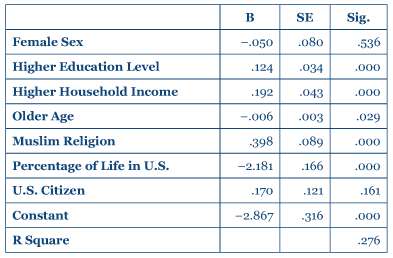
OLS Regression with Having and Regularly Communicating with
Family and Friends Outside the United States as Dependent Variable

Differences between Muslims and Christians
21A final look at demographic correlates asks whether these variables are related to media consumption and communication with family and friends in the Arab world in the same way among Muslims and Christians. The question, in other words, is not whether religion itself is an important independent variable but, rather, whether it specifies when other independent variables do or do not have explanatory power. To investigate this matter, the regressions presented above have been run separately for Muslim and Christian respondents, with religion of course removed from the models. For present purposes, this comparison is limited to the dichotomous categorization of religion, even though each category could be subdivided according to denomination or branch. 22Tables 6 and 7 present the results of this disaggregated analysis. Table 6 pertains to watching television from Arab countries, with the models for Christians and Muslims presented separately. Table 7, again with findings for Christians and Muslims presented separately, deals with the 5-point scale measuring communication with family and friends in other countries.Table 6
Logistic Regression among Christians and Muslims with
Watching Television Programs Originating in the Arab World as Dependent Variable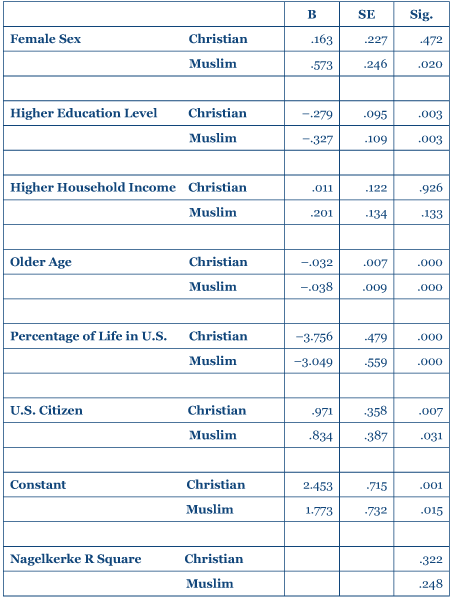
Logistic Regression among Christians and Muslims with
Watching Television Programs Originating in the Arab World as Dependent Variable

Table 7
OLS Regression among Christians and Muslims with Having and
Regularly Communicating with Family and Friends Outside the
United States as Dependent Variable
23Tables 6 and 7 reveal three different kinds of patterns. The first and most frequent concerns statistically significant relationships observed without disaggregation, as shown in Tables 3 and 5, that remain significant for both Christians and Muslims when the two religious groups are analyzed separately. In these cases, in other words, there are no differences in the relationships that characterize Christians and those that characterize Muslims. With respect to transnationalism in media behavior, this involves lower levels of education, younger age, and a smaller percentage of life lived in the U.S. With respect to having and communicating with family and friends in the Arab world, this involves higher levels of education, higher income levels, and, again, a smaller percentage of life lived in the U.S. For each of these variable relationships, there is no difference between Christians and Muslims; patterns reported earlier, shown in Tables 3 and 5, are applicable to Detroit’s Arab-Americans regardless of religion. Moreover, since this involves twelve of the sixteen statistically significant relationships reported in Tables 3 and 5, it may be concluded that the demographics and dynamics associated with transnationalism are in general the same for the Christian and Muslim members of the Arab-American community.
24A second pattern constitutes the only exception to this generalization. Specifically, there are two instances in which a statistically significant relationship reported in Table 3 or Table 5 applies to only one religious community. This occurs twice. First, the relationship between female sex and greater likelihood of watching television programs originating in the Middle East, reported in Table 3, is shown in Table 6 to apply only to Muslims. Second, the relationship between younger age and a greater likelihood of having and communicating regularly with family and friends in the Arab world, reported in Table 5, is also shown in Table 7 to apply only to Muslims. Although these observations do not detract from the broader conclusion that Christians and Muslims for the most part are similar so far as the dynamics shaping transnationalism are concerned, they do suggest that female sex and younger age are more likely to encourage transnationalism among Muslims than among Christians.
25Finally, there is one instance of a third pattern. This involves a relationship observed among both Christians and Muslims that was not found when the data were not disaggregated. Specifically, whereas Table 3 reported that being a U.S. citizen was inversely related to transnationalism in media consumption, Table 6 shows that for both Christians and Muslims being a U.S. citizen is positively related to watching television programs originating in the Arab world. While the reasons for this unexpected and somewhat anomalous finding are not immediately clear, it may be noted that this is yet another instance in which identical variable relationships characterize Christians and Muslims. Thus, a few exceptions notwithstanding, the main conclusion to be drawn from this analysis is that the same factors push toward transnationalism among Christians and Muslims and, accordingly, a focus on religious affiliation provides little additional explanatory power in this area.
OLS Regression among Christians and Muslims with Having and
Regularly Communicating with Family and Friends Outside the
United States as Dependent Variable
Impact on Political Assessments and Social Values
26This section explores the relationship between measures pertaining to transnational media consumption and communication with family and friends in the Middle East, on the one hand, and value and lifestyle assessments and political judgments, on the other. In the analysis to follow, the former are independent variables and the latter are dependent variables. 27Questions about social values and lifestyles ask respondents to indicate whether or not they believe each of the following is justified: divorce, women with young children working outside the home, consumption of alcohol, premarital sex, homosexuality, and abortion. For each of these considerations, as well as others not included in the present analysis, respondents were asked to indicate their views using a 10-point scale ranging from “can never be justified” to “can always be justified.” As shown in Table 8, each of these assessments pertaining to social values and lifestyles loads highly on a single factor when subjected to factor analysis, which indicates that they may be treated as indicators of a single unidimensional concept or construct. Accordingly, factor scores based on this analysis were generated for use in the present analysis. The dimension measured in this way can perhaps be described as tolerant-intolerant or permissive-not permissive. Responses to the question about women with small children working outside the home are presented in Table 9 in order to give a sense of the way that some social values and lifestyle assessments are distributed. The distribution on some other items is skewed toward the “can never be justified” end of the 10-point scale.Table 8
Factor Analysis of Survey Items Pertaining to Social Values
and Lifestyles
Factor Analysis of Survey Items Pertaining to Social Values
and Lifestyles
Table 9
Opinions about a Woman with Small Children
Working Outside the Home
28Political judgments included in the present analysis pertain to levels of confidence in American civic and political institutions, and specifically to levels of confidence in local public schools, the U.S. legal system, the local police, and the government in Washington. Judgments about each of these institutions again load highly on a single factor when subjected to factor analysis, and factor scores based on this analysis were again generated for use in the present analysis. The results of the factor analysis are shown in Table 10. Responses to the question about confidence in the U.S. government are presented in Table 11 in order to give a sense of the way that levels of confidence tend to be distributed.
Opinions about a Woman with Small Children
Working Outside the Home
Table 10
Factor Analysis of Survey Items Pertaining to Confidence
in Civic and Political Institutions
Factor Analysis of Survey Items Pertaining to Confidence
in Civic and Political Institutions
Table 11
Confidence in the Government in Washington, DC
29An examination of the relationships between these measures pertaining to social values and institutional confidence, on the one hand, and transnational media consumption and communication with friends and relatives outside the U.S., on the other, is not guided by specific hypotheses. It would be plausible to propose that greater involvement with the Arab world leads Detroit’s Arab-Americans to hold more progressive views on lifestyle and value questions and also to be more positively disposed toward American civic and political institutions. The logic here is that their greater familiarity with the inequalities and inefficiencies that predominate in many Arab countries, and about which many in the Arab world themselves regularly complain, would predispose Arab-Americans to have a more pluralist cultural perspective and a more favorable view of U.S. civic institutions.
30On the other hand, it would also be plausible to propose that transnational experience leads Arab-Americans to be more conservative on social issues and to have less confidence in civic and political institutions. In this case, the presumed logic is that greater involvement with the broader Arab world strengthens attachment to traditional norms and lifestyles and deepens exposure to a perspective that is critical of American politics. While these two possibilities may not, a priori, be equally persuasive, the point is that a logical case can be made that greater contact with societies in the Arab world that are more politically controlled and socially conservative increases appreciation and approval of the ways in which U.S. society differs, and also that this contact strengthens identification with different political and societal formulae and produces a distaste for things American, or at least, in the case of values and lifestyles, for norms that are perceived to be characteristically American.
31The logic and assumptions underlying both kinds of relationships are assessed in regression analyses in which dimensions of transnational behavior are independent variables. Both media consumption and communication with family and friends in the Middle East are considered. The dependent variables, as noted, are factor scores pertaining to approval-disapproval with respect to social values and lifestyles and to confidence in U.S. public and political institutions. Education, gender, household income, religion, age, percentage of life lived in the U.S., and citizenship are included in the analyses as control variables. Findings, with regressions that include only one independent variable and regressions that include both independent variables, are presented in Tables 12 and 13.
Confidence in the Government in Washington, DC
Table 12
OLS Regression with Factor Scores Indicating Approval of
Diverse Social Values and Lifestyles as Dependent Variable
OLS Regression with Factor Scores Indicating Approval of
Diverse Social Values and Lifestyles as Dependent Variable
Table 13
OLS Regression with Factor Scores Indicating Confidence in
Civic and Political Institutions as Dependent Variable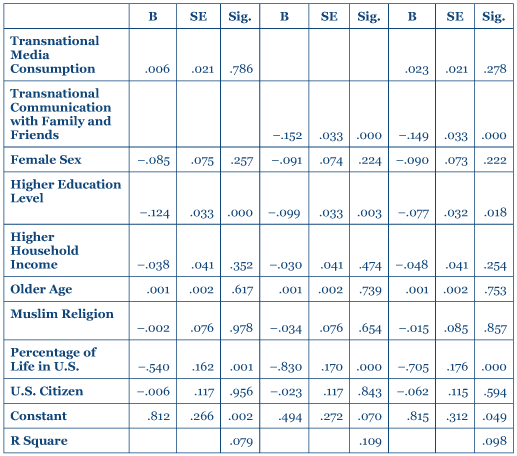
32Interestingly, one and only one of the independent variables pertaining to transnational communication is significantly and independently related to each dependent variable. Watching television programs originating in the Arab world is strongly related to the measure pertaining to lifestyles and values but not to the measure pertaining to confidence in American institutions. Conversely, having and regularly communicating with family and friends in the Middle East is strongly related to the measure pertaining to confidence in American institutions but not to the measure pertaining to lifestyles and values. This is the same whether the analysis includes only one independent variable or both independent variables.
33More specifically, with respect to the direction of the relationships, watching television programs originating in the Arab world is associated with lower approval of the values and lifestyles included in the measure, and regular communication with family and friends in Arab countries is associated with less confidence in U.S. public and political institutions. It is important to recall that these relationships were observed with other variables held constant, including education, percentage of life lived in the U.S., and other factors that were earlier shown to be related to the independent variables in the present analysis.
34It cannot be known for sure whether the causality in these statistically significant relationships flows in one direction, the other, or, more likely, both. While transnational experience may help to shape social and political predispositions, it is also possible that pre-existing judgments may themselves provide some of the motivation for deeper and more frequent transnational communication. Nevertheless, it can be said in response to questions about the connection between transnational activities and experiences, on the one hand, and social and political orientations, on the other, that the connection is significant, that it pushes in the direction of a more narrow perspective on lifestyle and normative issues and lower institutional confidence, and that the particular normative orientation on which they exert this push differs from one kind of transnational experience to the other.
35Although the intent of the analysis presented in Tables 12 and 13 is to assess relationships involving transnationalism, both tables show that other independent variables are also significantly and independently related to judgments about social values and lifestyles and about American public institutions. In both instances, higher education and percentage of life lived in the U.S. are associated with the dependent variables and, interestingly, the direction of the relationships in each instance varies from one dependent variable to the other. On the one hand, higher education and birth or longer residence in the U.S. are associated with greater likelihood of having a more tolerant and pluralist normative perspective. On the other, higher education and birth or longer residence in the U.S. are associated with lower likelihood of having confidence in the American public and political institutions.
36These findings are only partly consistent with the interpretations offered earlier and raise interesting questions for reflection and further investigation. To the extent that higher education and longer residence in the United States reflect stronger connections with the broader mainstream of American society, beyond that of the Arab-American community, findings pertaining to values and lifestyles reinforce the interpretations offered with respect to transnationalism. Specifically, just as transnationalism pushes toward a more traditional, conservative and ultimately restrictive normative outlook, lower education and shorter residence in the U.S. push in the same direction. However, a plausible and potentially important implication of this pattern is that transnationalism does not by itself foster a more conservative orientation but, rather, is a reflection and manifestation of the weaker connection to mainstream American society that is in fact where most of explanatory power is to be found. This possibility is reinforced by the fact that television viewing is the dimension of transnationalism associated with a more conservative perspective on values and lifestyles. Transnationalism in media behavior is most likely a response to fewer or more superficial connections with Americans outside the Arab-American community, making it less of a prime causal agent and more of an intermediate link, probably one among many, in the causal pathway that leads from weaker involvement in mainstream American society to a more traditional and conservative normative outlook.
37Findings pertaining to confidence in U.S. public and political institutions are equally suggestive with respect to insights about the impact of transnationalism. In this instance, higher education and birth or longer residence in the U.S. predict to lower confidence levels, indicating that stronger connections to the mainstream of American society pushes toward a negative rather than a positive view of governance and civic administration. This is opposite of the pattern observed with respect to social values and lifestyles, where transnationalism and stronger connections to mainstream America push in the same direction. And since longer and deeper experience in the U.S. tends to produce among Detroit’s Arab-Americans a disappointment in the performance and policies of American political institutions, it follows that the decline in transnationalism that comes with deeper involvement in American society will not by itself lead to greater confidence in U.S. civic institutions. This also suggests that transnationalism probably does not produce or reinforce an explicit preference for the particular institutional arrangements found in various Arab countries but, rather, helps to foster among Arab-Americans a view that their treatment by authorities in the U.S. is not different or better to the degree they would wish. This interpretation, too, is reinforced by the specific dimension of transnationalism that predicts to low confidence in U.S. institutions. The salient dimension in this case concerns regular contact with family and friends in the Arab world, which gives people a basis for comparing the impact of government performance and policy in the U.S. and abroad and concluding, presumably, that the former is not necessarily much more satisfactory than the latter.
38These interpretations go beyond the data but offer plausible insights about the social and interpersonal dynamics linking transnational communication to attitudes and assessments. Other interpretations are possible, of course, and these are to be encouraged. And both those offered here and others that might be advanced will hopefully be the focus of future empirical investigation. But while additional research is needed, the present study does offer clear evidence both that transnational communication exerts an influence on social and political orientations and that its impact should be understood in the context of interaction with other personal and situational factors, at least some of which play an equal or even greater role in shaping social values and political judgments.
OLS Regression with Factor Scores Indicating Confidence in
Civic and Political Institutions as Dependent Variable

Conclusion
39This research report is a straight-forward empirical investigation of the nature, extent, determinants, and consequences of transnational activity among Detroit’s Arab-Americans. It examines two different dimensions of transnational communication, one pertaining to watching television programs originating in the Arab world and the other pertaining to contact with family and friends residing in the Arab Middle East. In both cases, there is considerable variation in the extent of transnationalism, and in both cases it has been possible to identify demographic correlates of this variation. In addition, the analysis shows that each dimension of transnationalism predicts and to some extent explains variation in social values and political assessments. 40As noted in the introduction, there are forces both promoting and diminishing transnationalism among the Arab-Americans of greater Detroit. Global forces, including advances in international communications and transportation, make transnational involvement easier and less expensive than in the past. On the other hand, the importance of cross-national ties may diminish over time as immigrant communities deepen their incorporation into the mainstream of American society. Further, to the extent that communal identities remain important, these may be increasing based on ties to Arab-Americans throughout the United States rather than to countries or world regions of ancestry. Whether there will be movement in either of these directions is a question for future research, with the present study providing baseline data for purposes of comparison. In the meantime, however, so far as the present is concerned, it is clear both that there is significant transnational involvement among some but not all of Detroit’s Arab-Americans and that this has implications for how the members of this community think about and relate to American society and politics more generally. 41Finally, it should be recalled that this study is set in a particular historical moment, one marked by the terrorist attacks of September 11, 2001, and the subsequent U.S. “war on terrorism.” Further, while the special character of this period may have an impact on the outlook of Americans more generally, it has particular significance for Arab-Americans, and perhaps most especially for transnationalism among Arab-Americans. This means, as noted earlier, that patterns and relationships reported here may or may not obtain in more “normal” times, during periods when Arab-Americans face fewer barriers to interaction with the Arab Middle East and fewer questions are raised about their loyalty to the United States. This, too, is an empirical question to be investigated in the future, for which the present study again provides baseline data.Notes
1 The author acknowledges with appreciation the very helpful comments and input of Sally Howell on an earlier draft of this research report.
Author
Mark Tessler is Samuel J. Eldersveld Collegiate Professor of Political Science at the University of Michigan, where he is also Vice Provost for International Affairs. He previously served as Director of the Center for Political Studies of Michigan’s Institute for Social Research. Professor Tessler has attended university and/or conducted research in Tunisia, Israel, Morocco, Egypt, and Palestine (West Bank and Gaza). He is the author or coauthor of eleven books, including Area Studies and Social Science: Strategies for Understanding Middle East Politics; Democracy, War and Peace in the Middle East, and A History of the Israeli?Palestinian Conflict. Professor Tessler’s current research, funded by the National Science Foundation, the U.S. Institute of Peace, and the U.S. Department of State, deals with the attitudes and values of ordinary citizens in the Middle East toward issues of peace, democracy, religion, and gender. Recent reports of this research appear in Comparative Politics, World Politics, Journal of Conflict Resolution, International Studies Quarterly, Journal of Democracy, and Public Opinion Quarterly.
Suggested Citation
Tessler, Mark. “Transnational Communication among Arab Americans in Detroit: Dimensions, Determinants, and Attitudinal Consequences.” American Studies Journal 52 (2008). Web. 26 Apr. 2024. DOI 10.18422/52-03.

This work is licensed under a Creative Commons Attribution-ShareAlike 3.0 Unported License.


